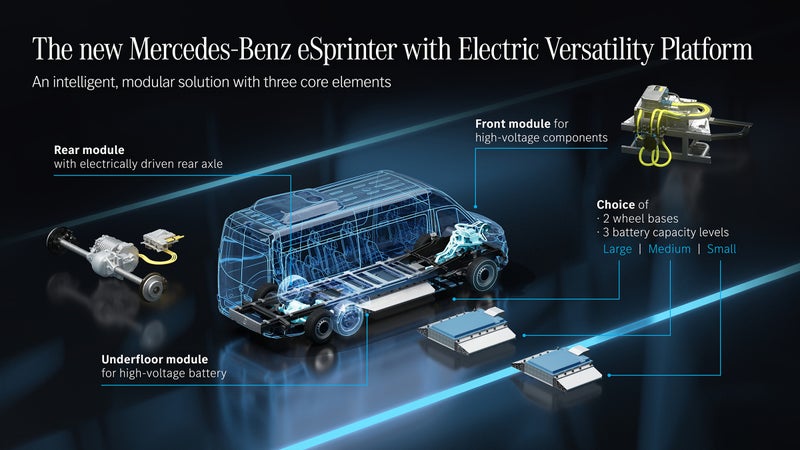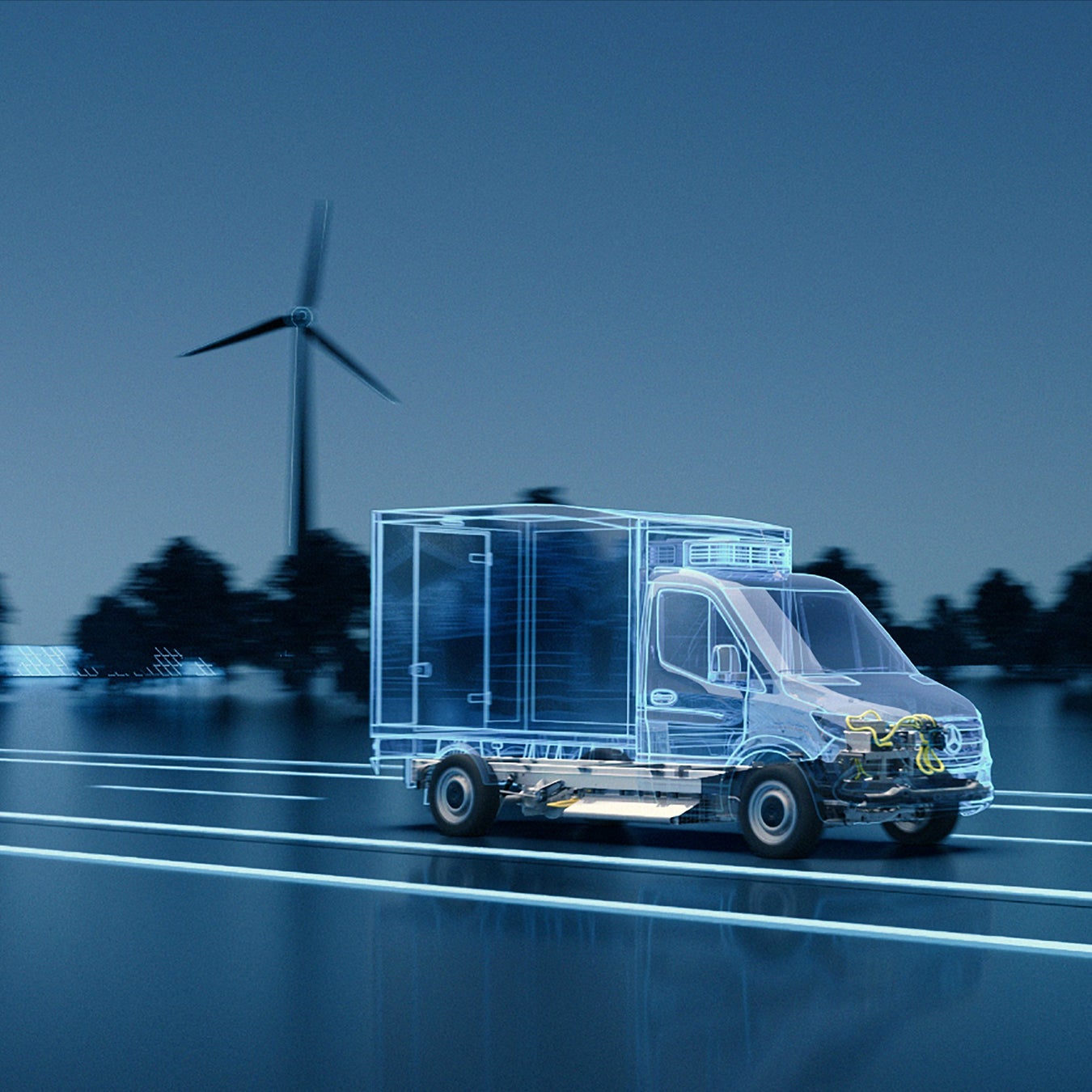Mercedes just announced that it will sell a fully electric version of its Sprinter van in the United States starting in 2023. Could this be the basis for the zero-emissions #vanlife build of your dreams?╠ř
To understand the electric Sprinter, you first need to understand the role vans like these play in other parts of the world. Visit Europe, for instance, and instead of seeing pickup truck after pickup truck clogging traffic, youÔÇÖll see Mercedes Sprinters and Ford Transits. Vans like these╠řare universal commercial vehicles there, performing any and every task you can imagine, from delivering the mail to carrying tradesmen between job sites.╠ř
In densely populated Europe, travel distances are often very short, and fuel is heavily taxed. So╠řoften╠řit makes sense for independent contractors and operators of large vehicle fleets to pay a premium for electric vans, even ones with very short ranges. Mercedes currently sells an electric Sprinter in Europe, but itÔÇÖs equipped with a small 55-kilowatt-hour (kWh) battery, giving it a range of only about 90 miles. Electric-vehicle batteries , so that tacks $11,000 to the price of that vehicle just for the battery pack. Run the numbers with European fuel prices and vehicle fees,╠řand that electric Sprinter might cost out for a plumber in Paris. But you can understand why Mercedes chose not to import it to the United States, where travel distances are longer and fuel is cheap.

What Mercedes is announcing this week is the development of an all-new Sprinter, designed from the ground up to accommodate both electric and internal-combustion drivetrains. That means there will be more room for batteries (up to 120 kWh), and Mercedes says that it will import that all-new Sprinter to the United States╠řin both electric- and internal-combustion engine forms. Sales are projected to begin here and in Europe in late 2023.
Vans like the Sprinter are starting to catch on as commercial vehicles on this continent.╠řThey offer vast amounts of fully enclosed╠řweather- and theft-resistant storage space, low load heights, and cheap running costs. Given that the 120-kWh battery should be good for a driving range of up to to 224 miles between charges, the electric version should be capable of serving delivery drivers and contractors here, especially in cities. If tax incentives are able to meaningfully offset the likely $24,000 premium that the battery pack will carry, it could be the right tool for some commercial users.╠ř
Here at ║┌┴¤│ď╣¤═°, we tend to think of vans not for their commercial utility╠řbut for their ability to serve as platforms for mobile living. They can carry people, dogs, and sports equipment into the outdoors, and╠řwith the right modifications, they can even be turned into apartments on wheels. More modifications might enable them to go off-road. The current Sprinter is the definitive #vanlife vehicle. So╠řwill the new electric model finally give╠řvan enthusiasts the ability to enjoy╠řzero emissions? The answer is more nuanced than it might seem.╠ř
The first challenge an electric Sprinter faces is price. The current internal-combustion model starts at around $35,000. If you want a really big╠řSprinter, or one with four-wheel drive, that price grows closer to $75,000. People often spend that much by╠řadding off-road capability╠řand building the interior into a comfortable living space. ThereÔÇÖs no getting around the fact that Sprinters become really expensive vehicles, really quickly. Buying an electric version with that 120-kWh battery pack is likely going to add $20,000 to $30,000 to all of the above.╠ř
The second challenge is going to come from all this talk of off-roading. In these renderings of the future Sprinter, Mercedes is showing a front-mounted electric motor driving the rear wheels, with the battery pack located amidships between the frame rails. ThatÔÇÖs an ideal layout for hauling heavy loads in a commercial environment, but two-wheel drive cannot provide the traction necessary to tackle challenging conditions off-road. And╠řadding four-wheel drive is not as easy on an electric vehicle as it is on one powered by dead dinosaur juice. Both current and future electric vehicles that are capable of driving all four wheels use at least one motor on each axle, and often one motor per wheel. ItÔÇÖs not currently clear if there is a provision for such an arrangement on this platform. And having╠řanother motor, or multiple motors, will also drastically increase both the already high price╠řand energy consumption.
Range is also going to be an issue: 224 miles is barely enough to truly╠řescape most cities. In states like California, which already have robust charging networks along popular travel routes, you may be able to easily grab a quick charge in a rural town╠řbefore heading into the mountains to camp. But╠řthat number is likely not an accurate representation of how the electric Sprinter will perform in real-world conditions. Both fuel economy and electric-vehicle ranges are calculated using a standard test procedure. While that procedure is good at giving you an idea of how a vehicle might perform in normal use, on paved roads, it often fails to consider factors that are common to how╠řoutdoorsy types tend to use╠řour vehicles. Stuff like carrying lots of weight (building out a van adds a lot), climbing steep grades, and operating in extreme temperatures all require vast amounts of energy. Together those things could reduce the electric SprinterÔÇÖs range by more than half. Even assuming youÔÇÖll be able to find a charging station at the last town before your adventure really starts, that gives you an effective travel radius of 56 miles, so you can get out there╠řand back. Bake in a margin for error, and youÔÇÖre just not taking this thing very far off the grid at all.╠ř
CouldnÔÇÖt you top off those batteries with solar panels mounted on the vanÔÇÖs roof? I have two 100-watt solar panels mounted on the roof of my Ford Ranger, and they charge╠řthe small battery that runs my fridge-freezer and onboard lights. It would take those panels 600 hours sitting in direct sunlight╠řto fully charge a 120-kWh battery. A van could fit a third╠řor maybe even a fourth panel, but adding those still wouldnÔÇÖt give you a charging time under two months (assuming five hours a day of direct sunlight).╠ř
So╠řif you really want to drive a zero-emission Sprinter on your next camping trip, youÔÇÖre going to need to make sure your destination is less than 56 miles from a charging station and╠řlocated along a route that doesnÔÇÖt involve extreme off-road challengesÔÇöand youÔÇÖll need to spend a lot of money in order to do that. Plus, you wonÔÇÖt be able to take that trip until early 2024. I hate to be the bearer of bad news, but itÔÇÖs going to be a few more years before #vanlife can really go green.╠ř


